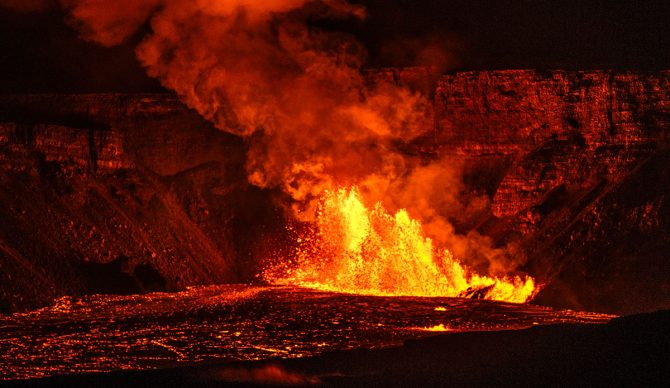
Kilauea is one of the world’s most active volcanoes, and on Monday morning it woke up again. Photo: NPS
Early on the morning of December 23, the Big Island’s Kilauea volcano began to erupt again. That’s not a huge surprise, as it is one of the world’s most active volcanoes, but it’s never boring.
The eruption so far has been confined to the summit caldera. It’s in a part of the Hawaiʻi Volcanoes National Park that’s closed to visitors for obvious reasons, but it’s hard to keep people away when the Earth begins to shake and lava is shooting nearly 300 feet in the air.
The U.S. Geological Survey has a livestream of the eruption going and it’s amazing to see. Lava shooting skyward, plumes of volcanic gas and ash quick on its heels.
“The lava is coming out at a very rapid rate as it usually does at the onset of these eruptions,” said Ken Hon, the lead scientist at the Hawaiian Volcano Observatory, during a USGS live stream.
Volcanic eruptions are — and hopefully you know this — unsafe to be around. Toxic gasses fill the air and lava is… well, lava is lava. The gasses, known as “vog,” a portmanteau of the words volcanic and fog, is full of sulfur dioxide which wreaks havoc on the lungs.
Kīlauea has been in the news relatively frequently in past years. Aside from a quick nap between 1924 and 1952, it’s been erupting regularly since we’ve been watching. Most recently and devastatingly, it spewed lava from May through August, leveling nearly 800 homes and changing the lives of pretty much anyone living in the area.
As of this writing, the Volcano Alert Level is at “Watch.” That means the risk is limited with no immediate threat to lives or buildings, but the levels of vog being belched out are worrisome. People with lung conditions like asthma are being warned to stay far away.
“Strong winds are blowing the massive plume of volcanic gas away from viewing areas towards the southwest over an area that has been closed to the public since 2008,” the National Parks Service wrote. “The plume reached about 6,000 feet above ground level at times. By 5:30 a.m., a lake of lava covered about 500 acres of the caldera floor and lava fountains in the southwest corner reached about 250 feet.”
Although you can still visit Hawaiʻi Volcanoes National Park, tourists and locals alike are warned to follow the precautions listed on the NPS website.

